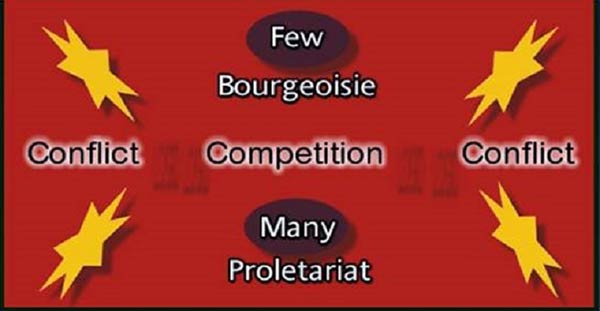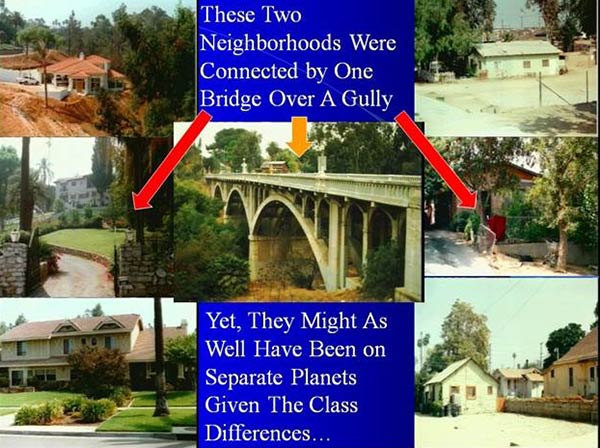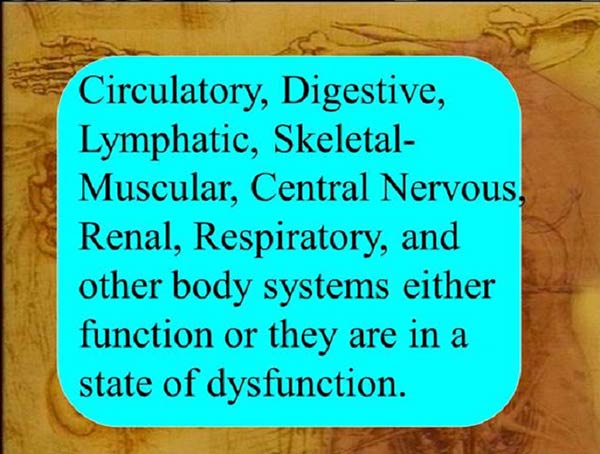Chapter 03 - Social Theories
Making Sense of Abstract Theories
Sociological theories are the core and underlying strength of the discipline. They guide researchers in their studies. They also guide practitioners in their intervention strategies. And they will provide you with a basic understanding of how to see the larger social picture in your own personal life. Theory=a set of interrelated concepts used to describe, explain, and predict how society and its parts are related to each other. The metaphor I’ve used for many years to illustrate the usefulness of a theory is what I call "The goggles metaphor." Goggles are a set of inter-related parts that help us see things more clearly. Goggles work because the best scientific components work together to magnify, enlarge, clarify, and expand to our view the thing we are studying.
Theories are sets of inter-related concepts and ideas that have been scientifically tested and combined to magnify, enlarge, clarify, and expand our understanding of people, their behaviors, and their societies. Without theories, science would be a futile exercise in statistics. In the diagram below you can see the process by which a theory leads sociologist to perform a certain type of study with certain types of questions that can test the assumptions of the theory. Once the study is administered the findings and generalizations can be considered to see if they support the theory. If they do, similar studies will be performed to repeat and fine-tune the process. If the findings and generalizations do not support the theory, the sociologist rethinks and revisits the assumptions they made.
Figure 1. The Theory Research Cycle

Here’s a real-life scientific example. In the 1960’s two researchers named Cumming and Henry studied the processes of aging. They devised a theory on aging that had assumptions built into it. These were simply put, that all elderly people realize the inevitability of death and begin to systematically disengage from their previous youthful roles while at the same time society prepares to disengage from them (see Maddox et al. 1987 The Encyclopedia of Aging, Springer Pub. NY) for much more detail. Cumming and Henry tested their theory on a large number of elderly persons. Findings and generalization consistently yielded a "no" in terms of support for this theory. For all intents and purposes this theory was abandoned and is only used in references such as these (for a more scientifically supported theory on aging Google "Activity Theory and/or Continuity Theory"). Theories have to be supported by research and they also provide a framework for how specific research should be conducted.
By the way theories can be used to study society—millions of people in a state, country, or even at the world level. When theories are used at this level they are referred to as Macro Theories. Macro theories are theories which best fit the study of massive numbers of people (typically Conflict and Functional theories). When theories are used to study small groups or individuals, say a couple, family, or team, they are referred to as being Micro Theories. Micro Theories are theories which best fit the study of small groups and their members (typically Symbolic Interactionism or Social Exchange theories). In many cases, any of the four main theories can be applied at either the macro or micro levels.
There are really two distinct types of theories: first, Grand Theories are theories which deal with the universal aspects of social processes or problems and is based on abstract ideas and concepts rather than on case specific evidence. These include Conflict, Functionalism, Symbolic Interactionism, and Social Exchange Theories; second, Middle-Range Theories are theories derived from specific scientific findings and focuses on the interrelation of two or more concepts applied to a very specific social process or problem. Robert K. Merton (1910-2003) was a functional theory-based sociologist who taught the value of using smaller more specifically precise theories in trying to explain smaller and more specific social phenomena. These theories include: Continuity, Activity, Differential Association, and Labeling theories. (see American Sociology Association, Theory SOURCE ).
Let's consider the 4 grand theories one at a time. The Conflict Theory is a macro theory. A Macro theory is a sociological theory designed to study the larger social, global, and societal level of sociological phenomena. This theory was founded by a German philosopher, economist, sociologist, and revolutionary (1818-1883). Marx was a witness to oppression perpetrated by society’s elite members against the masses of poor. He had very little patience for the capitalistic ideals that undergirded these powerful acts of inhumane exploitation of the average person. To him struggle was innate to all human societies. Later another German named Max Weber (1864-1920; pronounced "Veybur") further developed this sociological theory and refined it to a more moderate position. Weber studied capitalism further but argued against Marx’s outright rejection of it.
Conflict Theory
Conflict theory is especially useful in understanding: war, wealth and poverty, the haves and the have nots, revolutions, political strife, exploitation, divorce, ghettos, discrimination and prejudice, domestic violence, rape, child abuse, slavery, and more conflict-related social phenomena. Conflict theory claims that society is in a state of perpetual conflict and competition for limited resources. Marx and Weber, were they alive today, would likely use Conflict Theory to study the unprecedented bail outs by the US government which have proven to be a rich-to-rich wealth transfer.
Conflict Theory assumes that those who have perpetually try to increase their wealth at the expense and suffering of those who have not. It is a power struggle which is most often won by wealthy elite and lost by the common person of common means. Power is the ability to get what one wants even in the presence of opposition. Authority is the institutionalized legitimate power. By far the Bourgeoisie wealthy elite (royalty, political, and corporate leaders) have the most power. Bourgeoisie are the "Goliaths" in society who often bully their wishes into outcomes. The Proletariat are the common working class, lower class, and poor members of society. According to Marx (see diagram below) the Bourgeoisie and Proletariat cannot both have it their way and in order to offset the wealth and power of the Bourgeoisie the proletariat often rise up and revolt against their oppressors (The French, Bolshevik, United States, Mexican, and other revolutions are examples).
Figure 2. The Core Issues in the Conflict Theory

In fact Marx and Weber realized long ago that society does have different classes and a similar pattern of relatively few rich persons in comparison to the majority who are poor—the rich call the shots. Look below at the photographic montage of homes in one US neighborhood which were run down, poor, trashy, and worth very little. They were on the West side of this gully and frustrated many who lived on the East side who were forced to drive through these "slums" to reach their own mansions.
Figure 3. Photo Montage of Haves and Have Nots in a US Neighborhood

The Conflict Theory has been repeatedly tested against scientifically derived data and it repeatedly proves to have a wide application among many different levels of sociological study. That is not to say that all sociological phenomena are conflict-based. But, most Conflict theorist would argue that more often than not Conflict assumptions do apply. Feminist theory is a theoretical perspective that is couched primarily in Conflict Theory assumptions.
Recently a genius investment manager named Bernie Madoff was found to have run the most expensive Ponzi Scheme” in the history of the world SOURCE A Ponzi Scheme = a fraudulent investment scam where investors are promised above average returns on their investment, using monies recently contributed by newer investors to pay existing investors. This is done because it acts as “proof” to potential investors that the promised return is “real.” According to Conflict Theorists the wealthy elite receive the best education and intellectual heritage. They then turn around and exploit the more common, less well-educated members of society. Madoff took in $38 billion dollars, paid out $18 billion to investors and spent $18 billion (or put it in off-shore bank accounts). Over 24,000 victims will be compensated by Federal funds. Madoff was sentenced to 150 years in a medium security Federal Prison.
Functionalism or Structural Functionalism Theory
The next grand theory is called Functionalism or Structural Functionalism. Functionalist theory claims that society is in a state of balance and kept that way through the function of society's component parts. This theory has underpinnings in biological and ecological concepts (see diagram below). Society can be studied the same way the human body can be studied—by analyzing what specific systems are working or not working, diagnosing problems, and devising solutions to restore balance. Socialization, religious involvement, friendship, health care, economic recovery, peace, justice and injustice, population growth or decline, community, romantic relationships, marriage and divorce, and normal and abnormal family experiences are just a few of the evidences of functional processes in our society.
Figure 4. The Core Issues in the Functional Theory

Sure, Functionalists would agree with Conflict Theorists that things break down in society and that unfair treatment of others is common. These break downs are called Dysfunctions are breakdowns or disruptions in society and its parts, which threaten social stability. Enron’s collapse, the ruination of 14,000 employees’ retirement funds, the loss of millions in shareholder investments, and the serious doubt it left in the mind of US investors about the Stock Market’s credibility and reliability which lasted for nearly a decade are examples of dysfunctions in the economic sector of the economy. But, Functionalists also look at two types of functions: manifest and latent functions. Manifest functions are the apparent and intended functions of institutions in society. Latent functions are the less apparent, unintended, and often unrecognized functions in social institutions and processes.
Back to Enron, the government’s manifest function includes regulation of investment rules and laws in the Stock market to ensure credibility and reliability. After the Enron collapse, every company offering stocks for trade underwent a government supervised audit of its accounting processes in order to restore the public trust. For the most part balance was restored in the Stock Market (to a certain degree at least). There are still many imbalances in the investment, mortgage, and banking sectors which have to be readjusted; but, that’s the point society does readjust and eventually recovers some degree of function.
Does the government also provide latent or accidental functions to society? Yes. Take for example the US military bases. Of all the currently open US military bases, all are economic boons for the local communities surrounding them. All provide jobs, taxes, tourism, retail, and government contract monies that would otherwise go somewhere else. When the discussion about closing military bases comes up in Washington DC, Senators and members of Congress go to work trying to keep their community’s bases open.
As you can already tell, Functionalism is more positive and optimistic than Conflict Theory (the basis for much criticism by many Conflict Theorists). Functionalists realize that just like the body, societies get "sick" or dysfunction. By studying society’s parts and processes, Functionalists can better understand how society remains stable or adjusts to destabilizing forces when unwanted change is threatened. According to this theory most societies find that healthy balance and maintain it (unless they don’t and collapse as many have in the history of the world). Equilibrium is the state of balance maintained by social processes that help society adjust and compensate for forces that might tilt it onto a path of destruction.
Getting back to the Conflict Example of the gully separating extremely wealthy and poor neighborhoods, look at this Habitat for Humanity picture below. I took this close to my own home, because it represents what Functional Theorists claim happens—component parts of society respond to dysfunctions in ways that help to resolve problems. In this house the foundation was dug, poured, and dried within a week. From the foundation to this point was three working days. This house is now finished and lived in, thanks mostly to the Habitat non-profit process and the work of many volunteers. From the Functionalism perspective, optimism is appropriate and fits the empirical data gathered in society.
Figure 5. Photo of a Recently Finished Habitat for Humanity Home

Symbolic Interactionism Theory
Interactionism comes in two theoretical forms: Symbolic Interaction and Social Exchange. By far, my favorite sociological theory is Symbolic Interactionism. Symbolic Interaction claims that society is composed of ever present interactions among individuals who share symbols and their meanings. This is a very useful theory for: understanding other people; improving communications; learning and teaching skills in cross-cultural relations; and generally speaking, "not doing harm to your roommates" as many of my students often say after understanding this theory. Values, communication, witch hunting, crisis management, fear from crime, fads, love and all that comes with it, "evil and sin," what's hot and what's not, alien abduction beliefs, "who I am," litigation, mate selection, arbitration, dating joys and woes, and both personal national meanings and definitions (September 1, 2001—WTC) can all be better understood using Symbolic Interactionism.
Once you realize that individuals are by their social natures very symbolic with one another, then you begin to understand how to persuade your friends and family, how to understand others’ points of view, and how to resolve misunderstandings. This theory magnifies the concepts of meanings. Think about these three words, LOVE, LUST, and LARD. Each letter is a symbol. When combined in specific order, each word can be defined. Because we memorize words and their meanings we know that there is a striking difference between LOVE and LUST. We also know that LARD has nothing to do with either of these two terms (for most people at least). Contrast these word pairs: hate versus hope; help versus hurt; advise versus abuse; and connect versus corrupt. These words, like many others carry immense meaning and when juxtaposed sound like the beginning of philosophical ideas.
Symbolic Interactionism makes it possible for you to be a college student. It makes it so you understand your professors’ expectations and know how to step up to them. Our daily interactions are filled with symbols and an ongoing process of interactions with other people based on the meanings of these symbols. "How’s it going?" Ever had anyone you’ve greeted actually answer that question? Most of us never have. It’s a greeting not a question in the US culture (see culture chapter).
If you want to surprise someone, answer them next time they say "How’s it going?" If they have a sense of humor, they might get a kick out of it. If not, you may have to explain yourself. Symbolic Interactionism Theory explores the way we communicate and helps us to understand how we grow up with our self-concept (see socialization chapter). It helps you to know what the expectations of your roles are and if you perceive yourself as doing a good job or not in meeting those expectations.
There are many other Symbolic Interactionism concepts out there to study, let’s just talk about one more—The Thomas Theorem or Definition of the Situation. The Thomas Theorem is often called the "Definition of the situation" which is basically if people perceive or define something as being real then it is real in its consequences. I give a few examples from the media: a woman was diagnosed as HIV positive. She made her funeral plans, made sure her children would be cared for then prepared to die. Two-years later she was retested. It turned out her first test results were a false positive, yet she acted as though she had AIDS and was certainly going to die soon from it.
In a hypothetical case, a famous athlete (you pick the sport) defines himself as invincible and too famous to be held legally accountable for his criminal behavior. He is subsequently found guilty. A politician (you pick the party and level of governance) believes that his/her constituents will tolerate anything. When he/she doesn’t get reelected no one is surprised. The point is that when we define our situation as being real, we act as though it is real (regardless of the objective facts in the matter).
Symbolic Interactionism is very powerful in helping people to understand each other. Newlyweds, roommates, life-long friends, young adult children and their parents, and teammates can all utilize the principles to "walk a mile in the other’s shoes;" "see the world through their glasses;" and/or simply "get it." One of the major realizations that comes with Symbolic Interactionism is that you begin to understand the other people in your life and come to know that they are neither right nor wrong, just of a different point of view. They just define social symbols with varying meanings.
To understand the other person’s symbols and meanings, is to approach common ground. Listen to this statement by Rosa Parks (1913-2005), "All I was doing was trying to get home from work." In 1955 when she refused to give up her seat on the bus to a White person, it proved to be a spark for the Civil Rights Movement that involved the leadership of Martin Luther King Jr. and many other notable leaders. It was Rosa Park’s simple and honest statement that made her act of defiance so meaningful. The lion share of the nation was collectively tired and sick of the mistreatment of Blacks. Many Whites joined the protests while others quietly sympathized. After all that was written in the history books about it, a simple yet symbolic gesture by Rosa Parks symbolically started the healing process for the United States.
Social Exchange Theory
The remaining theory and second interactionist theory is Social Exchange. Social Exchange claims that society is composed of ever present interactions among individuals who attempt to maximize rewards while minimizing costs. Assumptions in this theory are similar to Conflict theory assumptions yet have their interactistic underpinnings. Basically, human beings are rational creatures, capable of making sound choices once the pros and cons of the choice are understood. This theory uses a formula to measure the choice making processes.
(REWARDS-COSTS)=OUTCOMES
or
("What I get out of it"-"What I lose by doing it")="My decision"
We look at the options available to us and weigh as best we can how to maximize our rewards and minimize our losses. Sometimes we get it right and other times we make a bad choice. One of the powerful aspects of this theory is the concept of Equity. Equity is a sense that the interactions are fair to us and fair to others involved by the consequences of our choices. For example, why is it that women who work 40 hours a week and have a husband who works 40 hours per week do not perform the same number of weekly hours of housework and childcare? Scientists have surveyed many couples to find the answer. Most often, it boils down to a sense of fairness or equity. Because she defines it as her role to do housework and childcare, while he doesn’t; because they tend to fight when she does try to get him to perform housework, and because she may think he’s incompetent, they live with an inequitable arrangement as though it were equitable (don’t get me started on the evidence that supports men sharing the actual roles of housekeepers and childcare providers—see Joseph Pleck, "Working Wives/ Working Husbands" Sage Pub, CA).
Each of us tries constantly to weigh pros and cons and to maximize the outcomes of our choices. I often provide a rhetorical challenge to my students when I ask them to go down to the cafeteria, pick the least attractive person they can find, take them on a date where they drive and they pay for everything, then give the person a 7 second kiss at the end of the date. "Why would we do that?" they typically ask. "That’s my point," I typically reply, having increased a bit of their understanding of the Social Exchange Theory.
Any of the four theories can be used to study any individual and collective behaviors. But, some do work better than others because their assumptions more precisely match the issue of interest. Divorce might be studied from the Conflict Theory to understand how things become adversarial and how and why contested divorces sometimes become violent. Divorce might be studied from the Functionalism Theory to understand how divorce is a means to resolving untenable social circumstance—it is a gesture designed to restore balance and equilibrium. Divorce might be studied using the Symbolic Interactionism Theory to identify how people define their roles before, during, and after the divorce and how they reestablish new roles as unmarried adults. Divorce might also be studied using the Social Exchange Theory to understand the processes and choices that lead to the final divorce decision, distribution of assets, child custody decrees and the final legal change of status (see Levinger and Moles, "Divorce and Separation: Context, Causes, and Consequences" 1979, Basic Books).
I've enclosed a simple summary sheet of the four basic theories used most by sociologists. It serves well as a reference guide, but can’t really replace your efforts to study sociological theories in more detail. On the next page I’ve enclosed a self-assessment that may help you to assess your leanings towards these four main theories and two others that are often used by sociologists. On the self-assessment don’t be surprised if you find that all four theories fit your world-view. Keep in mind they have been extensively studied for a very long time.
Introduction to Sociology: 4 Basic Theories

Your Dispositions Toward Theories
We have prepared a survey which you can download to help you understand how you feel about these four major theories.
Additional Resources
Search the keywords and names in your Internet browser
Key Sociological Concepts:
- Society
- Sociological perspective
- Social location
- Social Darwinism
- Class conflict
- Macro-level
- Micro-level
- Theoretical approach
- Mid-range theories within the Conflict perspective
- Mid-range theories within the Conflict Functional perspective
- Mid-range theories within the Conflict Symbolic Interactionism perspective
- Mid-range theories within the Conflict Social Exchange perspective
- Three stages of sociology
- Sociology in the context of globalization
- Middle income countries
- Low income countries
- High income countries
- Social structure
- Social functions
- Positivist sociology
- Interpretive sociology
- Marxian sociology
- Critical sociology
- Feminist sociology
- Personal Sociology
- Weberian sociology
- Basic or pure sociology
- Public sociology
- Applied "clinical" sociology
- Social construction
- Organic solidarity
- Social constraint
- Division of labor
- Materialist conception of history
- Capitalism
- Bureaucracy
- Rationalization
- Postmodernism
- Anomie
- Verstehen
- McDonaldism/McDonaldization
Key Founders:
- Auguste Comte (1798-1857)
- Emile Durkheim (1858-1917)
- Karl Marx (1818-1883)
- William Graham Sumner (1840-1910)
- Lester F. Ward (1841-1913)
- Herbert Spencer (1820-1903)
- Alexis de Tocqueville (1805-1859)
- Thorstein Veblen (1857-1929)
- Ferdinand Tönnies (1855-1936)
- Georg Simmel (1858-1918)
- Karl Mannheim (1893-1947)
- Max Weber (1864-1920)
- Jurgen Habermas (1929-)
- Jane Addams (1860-1935)
- George Herbert Mead (1863-1931)
- Talcott Parsons (1902-1979)
- Charles Cooley (1864-1929)
- C. Wright Mills (1916-1962)
- Harriet Martineau (1802-1876)
- Erving Goffman (1922-1982)
- Florian Znaniecki (1882-1958)
- Robert Merton (1910-2003)
- Anthony Giddens (1938-)
- Karl Mannheim